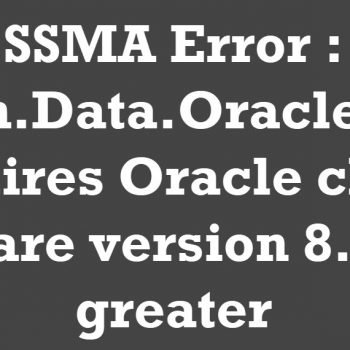Sometimes we are in a hurry that we forget activities that are pending. A typical example would be like walking into a room and we keep thinking about why we were there in the first place. Isn’t that common? Or I think age is catching on me for sure. Some of the classic mistakes I have seen people doing is to bring up an environment in a hurry and choose the Evaluation Edition because they don’t have the key handy at that point in time. They plan to add the same at a later point in time and forget it. One fine day SQL starts to error out and on inspection, you hit the problem and all work comes to a stop.
If you have been running SQL Server and it is expired, there would be a need to activate it. The steps are a little different as compared to Windows activation. The edition terminology is also little different from the Windows world. In SQL Server, evaluation edition is actually an enterprise edition of SQL Server, having 180 days’ time limit – so it is called as Enterprise Evaluation Edition
If the SQL Server engine is expired, the SQL services would not start and you will find below error in SQL Server error log and event viewer. Here is the blog to find a SQL ERRORLOG file location
SQL SERVER – Where is ERRORLOG? Various Ways to Find its Location
Here is the sample ERRORLOG. I have highlighted two things below – current version and error message. The same message will come in event log also.
2015-03-25 10:34:06.84 Server Microsoft SQL Server 2012 (SP1) - 11.0.3128.0 (X64)
Dec 28 2012 20:23:12
Copyright (c) Microsoft Corporation
Enterprise Evaluation Edition (64-bit) on Windows NT 6.2 <X64> (Build 9200: ) (Hypervisor)
2015-03-25 10:34:06.84 Server (c) Microsoft Corporation.
2015-03-25 10:34:06.84 Server All rights reserved.
2015-03-25 10:34:06.84 Server Server process ID is 6584.
2015-03-25 10:34:06.84 Server Authentication mode is MIXED.
2015-03-25 10:34:06.84 Server Logging SQL Server messages in file 'C:\Program Files\Microsoft SQL Server\MSSQL11.MSSQLSERVER\MSSQL\Log\ERRORLOG'.
2015-03-25 10:34:06.84 Server The service account is 'NT Service\MSSQL$MSSQLSERVER'. This is an informational message; no user action is required.
2015-03-25 10:34:06.84 Server Registry startup parameters:
-d C:\Program Files\Microsoft SQL Server\MSSQL11.MSSQLSERVER\MSSQL\DATA\master.mdf
-e C:\Program Files\Microsoft SQL Server\MSSQL11.MSSQLSERVER\MSSQL\Log\ERRORLOG
-l C:\Program Files\Microsoft SQL Server\MSSQL11.MSSQLSERVER\MSSQL\DATA\mastlog.ldf
2015-03-25 10:34:06.84 Server Command Line Startup Parameters:
-s "MSSQLSERVER"
2015-03-25 10:34:07.15 Server Error: 17051, Severity: 16, State: 1.
2015-03-25 10:34:07.15 Server SQL Server evaluation period has expired.
On the other hand, if client tools are expired, then we would have trouble opening SQL Server Management Studio and other client tools. Here is the pop-up which would be received.
Evaluation period has expired. For information on how to upgrade your evaluation software, please go to http://www.microsoft.com/sql/howtobuy

In such situations, we need to perform an activation of SQL Server. This is called as edition upgrade in SQL Server installation terminology. To upgrade, you need to have installation media of the destination version. SQL Server evaluation edition can be upgraded to standard, developer, enterprise editions. The complete upgrade metrics can be found in SQL Server books online https://msdn.microsoft.com/en-us/library/ms143393(v=sql.120).aspx
Here are the steps:
- From SQL Server installation media, launch setup.exe.
- From the SQL Server Installation Center click Maintenance, and then select Edition Upgrade

- It would launch Wizard where you need to keep on pressing next, next and finally “Upgrade”. Make sure that edition shown in the license terms screen is what you purchased.
Hope this would help.
Reference : Pinal Dave (https://darkslategrey-bat-805937.hostingersite.com)





